Back To The Depths
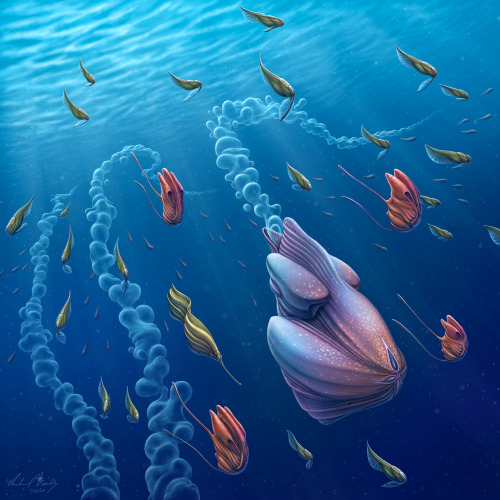
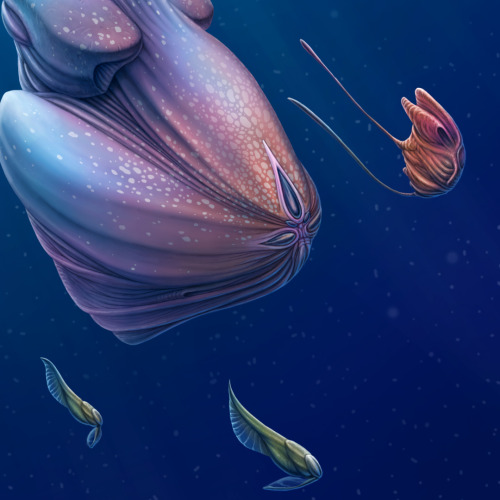
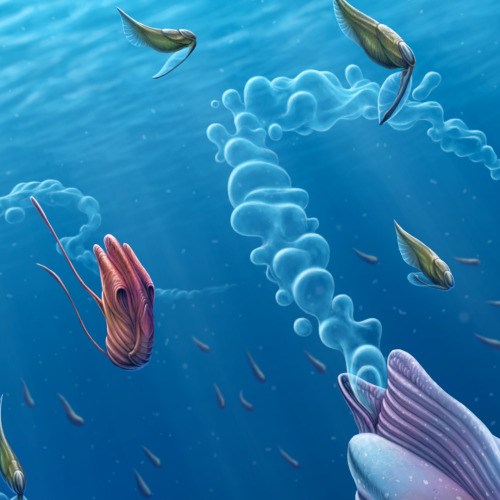
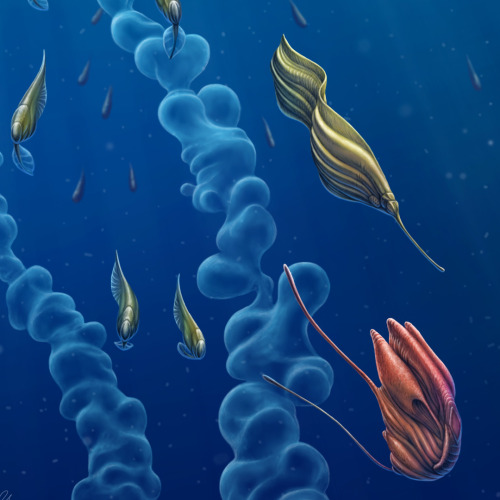
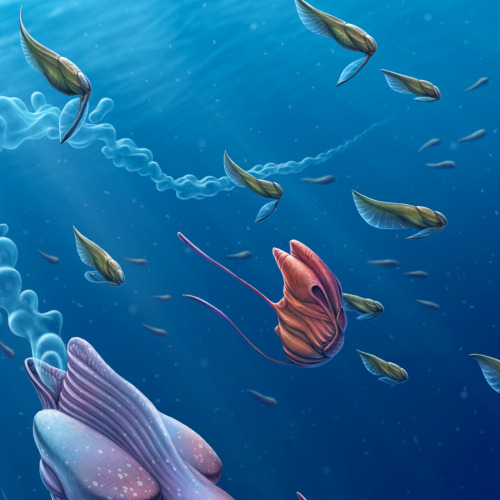
Back to the Depths
An entourage of opportunistic creatures accompanies the deep-sea behemoths during their brief ascent to the surface. Releasing their gelatinous strings of embryos here in the sunlight has a significant benefit - there's far more visibility. The swarm of followers are here in search of a quick meal in the form of the gelatin, which is full of valuable protiens and nutrients. After the feast however, the recipients of this apparent windfall become unwitting hosts for the behemoth's multitudinous offspring, which were embedded in the gel. Adapted to develop inside a wide variety of pelagic creatures, the young grow internally - and sometimes even on the surface of - their hosts until such time as they detach and sink back into the darkness. For most host species, this seems to be a mutually-beneficial symbiosis. At the beginning they receive a large and valuable meal, and usually incur very little detriment due to their temporary parasites. The young behemoths will hide in the dark depths for many years until attaining the size necessary to return to the light and repeat the ancient cycle again.
More Posts from Exobiotica and Others

Brand new website!
Check out Exobiotica.com for all your weird alien needs. Get prints, read new content, and go in-depth into the project. Enjoy!

Grandulus
Trifasciatus grandulus
I should preface the description of this creature by giving a short statement about the natural history of its home planet. Early in its evolutionary history, life on this world did not split into such rigidly defined taxa as it did on Earth. For example, the majority of multicellular earth-life is divided into autotrophic creatures (plants) which are immobile, and the highly mobile heterotrophs (animals). On grandulus’s planet, the peculiar biochemistry allows for a much higher rate of horizontal gene transfer and endocytosis. This means that instead of a taxonomic “tree of life” like on Earth, their evolutionary history looks more like a web. In short, this allows for a wide array of photosynthetic, yet mobile creatures. The grandulus is one of these. It moves around slowly with its sticky appendages and positions itself in a spot with maximum sunlight to unfold its inflatable photosynthetic organ from its posterior shell. It also feeds on the internal fluids of metaflora, as well as decaying organic matter. Its many species range in size from that of a quarter to the size of a hippo.



Placid Segmaris
Caelumbestiae placidus
The Placid Segmaris is the sole food source of the Sky Shepherd. They are essentially floating livestock that are nurtured, herded, and protected until such time as the shepherds need to consume them. The tri-part symbiosis between the Sky Shepherds, the Segmaris, and their large floating counterpart (partially visible as the reddish-brown creature on the right side of the image) is rather complicated, and will be the subject of further works. Helpless on their own, the Segmaris relies on its symbionts for neary everything- protection, reproduction, much of their locomotion, and Hydrogen. The only thing it is capable of accomplishing by itself is the acquisition of food- which is does by filtering particles and small microfauna from the dense atmosphere where it lives. Adults are around 50 feet long at maximum, young start out around a foot long.

Egg Chamber
In some environments, it's hard to tell the difference between genders and species. Organisms share genetic material more easily on this planet, and that leads to some complicated taxonomy. In this case, we see a group of aquatic creatures acting as nurses for a seemingly endless field of eggs. But the network of underwater chambers in which they reside is in fact another living creature. By some categorizations, it would be considered the female of the species - it produces and to some extent nourishes the field of eggs, some of which mature to be gigantic network-chambers themselves. Whether this is an extreme example of sexual dimorphism, or the result of some sort of horizontal gene transfer is a matter of conjecture at this point.

Veteris-42820 C
Finally a planet to house (most of) the creatures I've designed so far. A terrestrial planet with about 2/3 the mass of Earth, it orbits its K-type star, Veteris, within the habitable zone. This system is around 8 billion years old - about twice that of ours, hence the name Veteris, which is Latin for "old". It sits at the outskirts of the nebula behind it, which will still be busy birthing star systems for billions of years to come. Veteris is a good analog for earth- it has a similar chemical composition (including its atmosphere, which is slightly more dense - at about 1.5 atm) so it's a good place to begin our journey.

This was a colored-pencil rendering of the creatures involved in the ecosystem portrayed in the "Aglow" piece. The pancake creatures on the floor are mobile decomposers. The floating lanterns are semi-autotrophic creatures that travel in groups. They travel by spouting air directionally through their vents which are visible along the middle of their bodies.



More strange megafauna.



Pelagic predator pen sketch. More on this soon.

Part of a color study for the next painting I plan to start this week.

-
 tadpoles-yay liked this · 6 months ago
tadpoles-yay liked this · 6 months ago -
 tundragravedigger reblogged this · 9 months ago
tundragravedigger reblogged this · 9 months ago -
 tundragravedigger liked this · 9 months ago
tundragravedigger liked this · 9 months ago -
 ara6gir liked this · 10 months ago
ara6gir liked this · 10 months ago -
 lamehandle liked this · 10 months ago
lamehandle liked this · 10 months ago -
 jayjayzzzzzz liked this · 1 year ago
jayjayzzzzzz liked this · 1 year ago -
 shrillestceiling liked this · 1 year ago
shrillestceiling liked this · 1 year ago -
 neddalian liked this · 1 year ago
neddalian liked this · 1 year ago -
 crepuscular-girlthing liked this · 1 year ago
crepuscular-girlthing liked this · 1 year ago -
 sanemeks liked this · 1 year ago
sanemeks liked this · 1 year ago -
 jankiwen liked this · 1 year ago
jankiwen liked this · 1 year ago -
 wtrotsky-blog liked this · 1 year ago
wtrotsky-blog liked this · 1 year ago -
 pomegristle reblogged this · 2 years ago
pomegristle reblogged this · 2 years ago -
 spiffyspidr liked this · 2 years ago
spiffyspidr liked this · 2 years ago -
 greatpartyhandscowboy liked this · 2 years ago
greatpartyhandscowboy liked this · 2 years ago -
 gray-science liked this · 2 years ago
gray-science liked this · 2 years ago -
 noodle-of-war liked this · 2 years ago
noodle-of-war liked this · 2 years ago -
 talos-4 liked this · 2 years ago
talos-4 liked this · 2 years ago -
 scientificallyaccuratedragon reblogged this · 2 years ago
scientificallyaccuratedragon reblogged this · 2 years ago -
 subduction-induction liked this · 2 years ago
subduction-induction liked this · 2 years ago -
 sebas1911 liked this · 2 years ago
sebas1911 liked this · 2 years ago -
 walkingmybird liked this · 2 years ago
walkingmybird liked this · 2 years ago -
 nillsaur liked this · 2 years ago
nillsaur liked this · 2 years ago -
 thezetriksystem liked this · 2 years ago
thezetriksystem liked this · 2 years ago -
 skullsulker liked this · 2 years ago
skullsulker liked this · 2 years ago -
 shitou456 liked this · 3 years ago
shitou456 liked this · 3 years ago -
 mothman1983 liked this · 3 years ago
mothman1983 liked this · 3 years ago -
 virtua reblogged this · 3 years ago
virtua reblogged this · 3 years ago -
 omegaxenonaut liked this · 3 years ago
omegaxenonaut liked this · 3 years ago -
 tom-tomorrow reblogged this · 3 years ago
tom-tomorrow reblogged this · 3 years ago -
 infamousrunawayxnginxxr liked this · 3 years ago
infamousrunawayxnginxxr liked this · 3 years ago -
 bluedotjpeg liked this · 3 years ago
bluedotjpeg liked this · 3 years ago -
 sinnersinsuits liked this · 3 years ago
sinnersinsuits liked this · 3 years ago -
 mrmcperson liked this · 3 years ago
mrmcperson liked this · 3 years ago -
 strangelightspyweasel liked this · 3 years ago
strangelightspyweasel liked this · 3 years ago -
 aphid-kirby liked this · 3 years ago
aphid-kirby liked this · 3 years ago -
 jeremy-remy-davis liked this · 3 years ago
jeremy-remy-davis liked this · 3 years ago -
 squirrel-stars liked this · 3 years ago
squirrel-stars liked this · 3 years ago -
 iamblessedtruly liked this · 3 years ago
iamblessedtruly liked this · 3 years ago -
 hellofoggyflowerbouquetthings liked this · 3 years ago
hellofoggyflowerbouquetthings liked this · 3 years ago -
 happyzenmonk reblogged this · 3 years ago
happyzenmonk reblogged this · 3 years ago -
 happyzenmonk liked this · 3 years ago
happyzenmonk liked this · 3 years ago